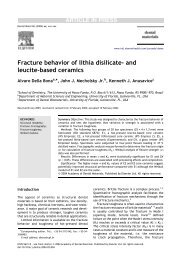Micro-tensile bond strength of adhesives bonded to class-I cavity ...
Micro-tensile bond strength of adhesives bonded to class-I cavity ...
Micro-tensile bond strength of adhesives bonded to class-I cavity ...
Create successful ePaper yourself
Turn your PDF publications into a flip-book with our unique Google optimized e-Paper software.
1000<br />
Introduction<br />
Thermo-cycling is a widely used artificial aging<br />
methodology. The ISO TR 11450 standard [1]<br />
indicates that a thermo-cycling regimen comprising<br />
500 cycles in water between 5 and 55 8C is an<br />
appropriate artificial aging test. A recent literature<br />
review [2] concluded that 10,000 cycles corresponds<br />
approximately <strong>to</strong> 1 year <strong>of</strong> in vivo functioning,<br />
rendering 500 cycles, as proposed by the ISO<br />
standard, very minimal <strong>to</strong> mimic long-term <strong>bond</strong>ing<br />
effectiveness.<br />
The artificial aging effect induced by thermocycling<br />
can be two-fold: (1) hot water may accelerate<br />
hydrolysis <strong>of</strong> non-protected collagen and<br />
extract poorly polymerized resin oligomers [3–5];<br />
(2) due <strong>to</strong> the higher thermal contraction/expansion<br />
coefficient <strong>of</strong> the res<strong>to</strong>rative material (as<br />
compared <strong>to</strong> that <strong>of</strong> <strong>to</strong>oth tissue) repetitive<br />
contraction/expansion stresses are generated at<br />
the <strong>to</strong>oth–biomaterial interface. This may result in<br />
cracks that propagate along <strong>bond</strong>ed interfaces, and<br />
once a gap is created, changing gap dimensions can<br />
cause in- and outflow <strong>of</strong> pathogenic fluids, a process<br />
known as ‘percolation’ [2,6]. In the light <strong>of</strong> the first<br />
aging effect (diffusion-dependent hydrolysis and<br />
elution), thermo-cycling should be applied <strong>to</strong><br />
micro-specimens, <strong>of</strong> which the interface is directly<br />
exposed <strong>to</strong> the changing temperature environment.<br />
Then, degradation <strong>of</strong> the adhesive–<strong>to</strong>oth interface<br />
is most severe, clinically corresponding <strong>to</strong> the most<br />
vulnerable res<strong>to</strong>ration margins. Aging <strong>of</strong> mTBSspecimens<br />
might also be more appropriate than<br />
aging <strong>of</strong> the larger ‘shear-<strong>bond</strong>’-<strong>strength</strong> specimens,<br />
because the surrounding composite and<br />
<strong>to</strong>oth tissue may thermally protect the adhesive–<br />
<strong>to</strong>oth interface. If the second aging effect (repetitive<br />
contraction/expansion stress) is focused upon,<br />
thermo-cycling should be applied <strong>to</strong> specimens in<br />
which stress similar <strong>to</strong> that occurring clinically can<br />
be generated. In vivo stress will be generated if the<br />
ratio <strong>of</strong> <strong>bond</strong>ed <strong>to</strong> un<strong>bond</strong>ed surfaces or the<br />
‘C-fac<strong>to</strong>r’ is high [7]. Clinically, about the highest<br />
C-fac<strong>to</strong>r is generated in narrow occlusal <strong>class</strong>-I<br />
cavities. In this case, thermo-cycling <strong>of</strong> the whole<br />
<strong>to</strong>oth including the high C-fac<strong>to</strong>r res<strong>to</strong>ration will<br />
result in the highest possible stress imposed at the<br />
interface.<br />
It is, however, not clear whether or not thermocycling<br />
affects the <strong>bond</strong> <strong>strength</strong> <strong>to</strong> dentin. A<br />
recent meta-analysis [8], concerning data published<br />
between 1992 and 1996, concluded that<br />
thermo-cycling has no significant effect on <strong>bond</strong><br />
<strong>strength</strong>. Most studies included in the meta-analysis<br />
were carried out following the ISO standard <strong>of</strong> 500<br />
cycles (mean number <strong>of</strong> cycles in the studies<br />
analyzed was 630). This number <strong>of</strong> cycles was<br />
probably <strong>to</strong>o low <strong>to</strong> obtain an aging effect [2,8,9].<br />
Also specimen geometry has <strong>of</strong>ten not been taken<br />
in<strong>to</strong> account. In most studies <strong>of</strong> this review,<br />
relatively large composite cylinders <strong>bond</strong>ed <strong>to</strong> flat<br />
surfaces were thermo-cycled, prior <strong>to</strong> being pulled<br />
apart following a shear or <strong>tensile</strong> <strong>bond</strong> <strong>strength</strong><br />
test pro<strong>to</strong>col [8]. As a result, a large part <strong>of</strong> the<br />
interface must have been thermally protected<br />
by surrounding dentin [10] and composite [11]<br />
(which are known <strong>to</strong> be good thermal insula<strong>to</strong>rs).<br />
Because <strong>of</strong> the low C-fac<strong>to</strong>r <strong>of</strong> a flat res<strong>to</strong>red<br />
surface (about 1/6), little repetitive expansion/<br />
contraction stress must have been generated at the<br />
interface. Both reasons might explain why thermocycling<br />
did not affect <strong>bond</strong>ing effectiveness in those<br />
studies.<br />
Therefore, the purpose <strong>of</strong> this study was <strong>to</strong><br />
evaluate the relative contribution <strong>of</strong> diffusiondependent<br />
chemical degradation and repetitive<br />
contraction/expansion stress on the thermocycling-induced<br />
degradation <strong>of</strong> dentin–adhesive<br />
interfaces at the bot<strong>to</strong>m <strong>of</strong> occlusal <strong>class</strong>-I cavities.<br />
The hypothesis tested was that thermo-cycling <strong>of</strong><br />
res<strong>to</strong>red <strong>class</strong>-I cavities (repetitive contraction/expansion<br />
stress), as well as <strong>of</strong> mTBS-sticks (diffusiondependent<br />
hydrolysis and elution) does not<br />
decrease <strong>bond</strong>ing effectiveness.<br />
Materials and methods<br />
Specimen preparation<br />
J. De Munck et al.<br />
For this study, non-carious human third molars<br />
(gathered following informed consent approved by<br />
the Commission for Medical Ethics <strong>of</strong> the Catholic<br />
University <strong>of</strong> Leuven), s<strong>to</strong>red in 0.5% chloramine<br />
solution at 4 8C were used within 1 month after<br />
extraction. First, all teeth were mounted in gypsum<br />
blocks in order <strong>to</strong> ease manipulation. A standard<br />
box-type <strong>class</strong>-I <strong>cavity</strong> (4.5!4.5 mm) was then<br />
prepared at the occlusal crown center with the<br />
pulpal floor ending at mid-coronal dentin, using a<br />
high-speed hand piece with a cylindrical mediumgrit<br />
(100 mm) diamond bur (842; Komet, Lemgo,<br />
Germany) mounted in a <strong>Micro</strong>Specimen Former<br />
(University <strong>of</strong> Iowa, Iowa City, IA, USA). Next, the<br />
cavities were subjected <strong>to</strong> a <strong>bond</strong>ing treatment<br />
(Table 1) using either a three-step etch and rinse<br />
adhesive (OptiBond FL), a two-step self-etch<br />
adhesive (Clearfil Protect Bond) or a one-step<br />
self-etch adhesive (iBOND). Subsequently, the<br />
cavities were filled in three horizontal layers with<br />
a resin-composite (Z100, 3M ESPE, St Paul, MN,
















